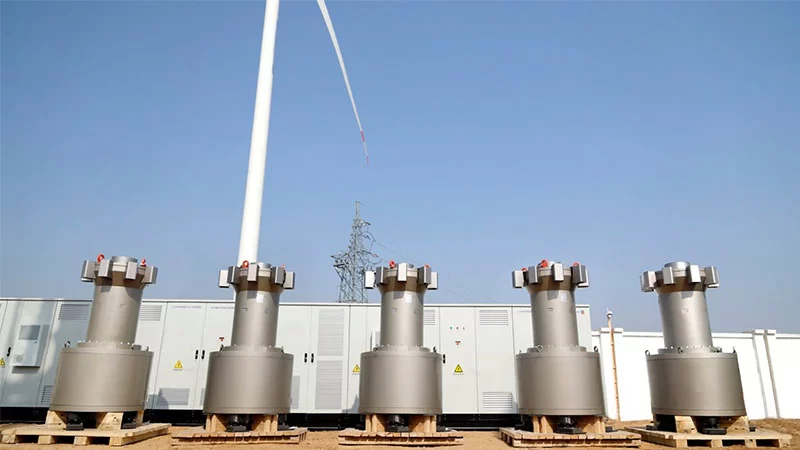Flywheel Energy Storage: A Battery Alternative to Solar Power

Flywheel energy storage is not a new technology for battery options; it is being considered for increasing application in solar energy systems. The whole world is running smoothly on a renewable backbone. Crucially, this must maintain the electricity consumption of solar energy generation. The lightning has not survived by usage alone; flywheel facilities have their performance, lifetime, and ecological safeguards and are now ready to develop their market share.
In summary, flywheel energy storage is a solution to unequal consumption of electricity and solar power generation, characterized by high performance, sustainability, and reliability.
Understanding Flywheel Energy Storage Systems (FESS)
How simple the mechanism of a flywheel energy storage system is! Just take it around the spinning objects, and that's how it stores energy. Imagine a giant wheel accelerated in a frictionless state, usually a vacuum environment, where electricity is converted into kinetic energy. When you want to use energy, the wheel slows and the system generates previously stored kinetic energy as electrical energy.
Some most critical components in the flywheel system:
- Rotor (flywheel): This is a very high-speed rotating component and of extremely high quality.
- Vacuum shell: this shell can reduce air resistance and become more efficient.
- Magnetic Bearings: minimize friction and wear.
- Electric generator: It is utilized to convert electrical energy into mechanical energy.
Why Flywheel Energy Storage Is an Ideal Match for Solar Power
Flywheel energy storage not only sounds realistic but is also practiced in field applications smoothing solar power generation fluctuation. The practical applications are enlisted below:
- Rapid charging and discharging: Solar power generation peaks at noon, but the demand on the power grid peaks in the afternoon to evening. Hence, a flywheel can rapidly store that extra electricity and discharge it when the load is maximal.
- Short-term storage: Such systems give a very good answer to short-term storage - up to four hours - which happens also to be when solar production drops and demand is the highest.
- Grid support: Flywheel systems can also provide other services important to the grid in addition to power storage:
- Primary frequency regulation
- Voltage stability
- Rotational inertia balance for the grid
Comparing Flywheel Energy Storage to Traditional Batteries
To better understand the strengths of flywheel systems, let’s compare them directly to conventional battery storage:
| Feature | Flywheel Energy Storage | Battery Storage (e.g., Lithium-ion) |
| Storage Type | Mechanical | Chemical |
| Response Time | Milliseconds | Seconds |
| Lifespan | 20+ years | 5–10 years |
| Efficiency | 85–90% | 80–90% |
| Environmental Impact | Low | Moderate to High |
| Maintenance | Minimal | Moderate to High |
| Temperature Sensitivity | Low | High |
Key Advantages of Flywheel Energy Storage
Long Lifespan
Flywheel technology overcomes the key drawback of chemical batteries, namely degradation during usage. The inertness of flywheels allows them to degrade only slightly over long periods, which stretches the longevity of the device up to a few decades.
Eco-Friendly Materials
Flywheels are generally made of recyclable materials with much greater availability, such are metals like steel, while lithium-ion batteries use limited metals. The absence of toxic substances renders end-of-life disposal manageable and hassle-free.
Temperature Resilience
Flywheel systems maintain efficiency over the widely varied temperature ranges, thereby making them suitable for use in hostile settings, which is the exact opposite in the case of batteries, which can be easily damaged with extreme in either hot or cold conditions.
Applications: Time-Shifting Solar Energy with Flywheels
The flywheels are a durable solution for time-shifting energy, which is a vital application in solar systems.
Working Mechanism
- At noon, excess solar power is diverted to the flywheel system.
- During the late afternoon/evening, energy is released quickly to meet the rising demand.
Best Application Cases
- Commercial solar installations
- Microgrids and off-grid facilities
- Utility-scale solar farms with intermittent generation
Challenges of Flywheel Energy Storage
However, despite its immense potential, flywheel energy storage has its drawbacks:
Lower Energy Density
Flywheels still cannot be used as energy sources for long periods. Driving overnight or through cloudy days longer than a few days would require an enormous flywheel installation.
High Upfront Costs
It requires more initial upfront capital investment compared to most battery systems. This more than offsets the depreciation of maintenance and longevity benefits.
Space Considerations
Flywheel systems take up more physical space than battery units are small, and they need to be installed in areas where their rotating forces and safety requirements can be accommodated.
The Future Role of Flywheels in Renewable Energy
The more the grid depends on renewables, the more flexible and responsive storage technology will be required. Flywheel energy storage serves a critical niche where high reliability and short surges are required, and while it is not likely to displace batteries in the future, it will form part of a hybrid storage application to back batteries.
Coming Developments are:
- Mosquito-sized flywheel technology for city-wide applications
- Integrating with AI-based energy management systems
- Adoptionof charging networks in electric vehicles
Final Thoughts
There is undoubtedly more to flywheel energy storage than serving as an alternative for the battery-it is really about a new generation of the way we think about power storage and transmission. Since timing is everything in solar power, flywheels offer a minute, trustworthy, and clean method of addressing the gap between generation and demand.
With more investment and innovation, these flywheel systems can very likely become the focal points of the clean energy future.
